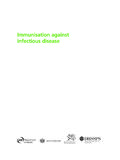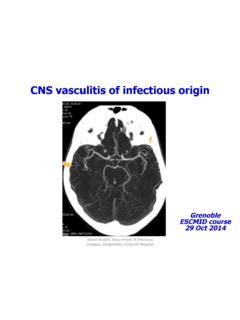Transcription of Vaccines against tick-borne encephalitis (TBE) WHO ...
1 1 Vaccines against tick- borne encephalitis (TBE) WHO position paper 10 June, 2011 Grading of scientific evidence in support of key recommendations Table IV(a). Is protection against clinical TBE waning >3-5 years after one booster in individuals <60 years of age who previously received primary TBE immunization? (Assessment based on Western TBE- Vaccines only) Rating Adjustment to score Quality Assessment No of Studies/Starting Score 5 observational1 2 Factors decreasing confidence Limitation in study design None serious 0 Inconsistency None serious 0 Indirectness Serious2 -1 Imprecision None serious 0 Publication bias None serious 0 Factors increasing confidence Large effect Not applicable 0 Dose-response Not applicable 0 Antagonistic bias and confounding Not applicable 0 Final Score 1 Summary of Findings Quality We have very little confidence in the estimate of the effect on the health outcome.
2 Conclusion There is no evidence of waning protection > 3-5 years after a booster following the primary series. Available evidence suggests that following a booster dose of TBE- vaccine , protection against clinical TBE persists for at least 6- 8 years 1 There are no trials on vaccine efficacy against clinical TBE; indirect evidence of protection is provided by trials using immunogenicity (in this case mainly induction of neutralizing antibodies) as an endpoint. Regardless of which of the two Western TBE vaccine that is used, all long-term serological studies show very low rates of waning of neutralizing antibody titres during the first 3-5 years following the booster. Also, where observation periods of up to 6-8 years have been achieved, neutralizing antibody titres suggesting protective immunity against TBE persist in the vast majority of vaccinees.
3 Although on rare occasions break-through infections occur, (mostly in individuals aged >60 years), the incidence of break-through infections does not increase with time since last rather than clinical protection is used as an endpoint. There is a lack of a standardized serological correlate of protection. 2 Studies on duration of protection following TBE vaccination. A total of 222 adults 19-51 years of age were followed up serologically for 3 and 5 years after their first booster dose (Encepur Adults). High antibody titres were recorded throughout the follow-up period. Neutralization test (NT) titres 10 were noted in 99% of subjects 3 and 5 years after the first booster vaccination (Plentz A et al 2009). Paulke-Korinek et al (2009) in a 6-year follow up study of 195 vaccinees who had previously received primary TBE vaccination (Encepur Adults) and at least one booster , all remained seropositive (NT titres 1:2) throughout the observation period.
4 In the age group <60 years, 94% had NT titres considered to be protective ( 1:10) six years after the last vaccine dose (86% in subjects aged 60 years). Rendi-Wagner (2007) found NT titres 10 in 96% (187/195) of the Encepur Adults- vaccinated subjects at year 2, and 97% (232/240) at year 3 post-booster. An analysis by Wittermann C et al (2009), showed that 275 of 278 (99%) and all 190 (100%) of Encepur Children recipients who completed the follow-up at 3 and 5 years, respectively, had NT titres 10. A longitudinal study in Sweden by Vene S et al (2007) showed that after the 3 primary doses of FSME-IMMUN , neutralizing antibody titers of 1:5 persisted in 77% of the vaccinees before administration of the first booster dose, and in 89-95% of 535 adult vaccinees before administration of the second and third boosters (about 3 year intervals between doses).
5 Recent data indicate that in more than 90% of vaccinees, the primary series of TBE vaccination plus one TBE booster induce neutralizing antibody levels that remain stable for at least 8 years and that the occasional break-through infections occurs independent of time since last immunization (WHO Background paper). Breakthrough infections in vaccinated individuals are rare, but do occur, particularly in elderly individuals (Stiasnyet al. 2009, Andersson et al 2010). Thus, 25 breakthrough cases were reported in Austria between 2002-2008, 8 of whom vaccinated according to the regular vaccination scheme, and during the period 2000-2008, 27 break-through cases were described in Sweden, of whom 21 had received 2 doses according to schedule.
6 (Neither study tries to assess the incidence of break-through infections among vaccinated individuals). References Andersson CR, Vene S, Insulander M, Lindquist L, Lundkvist A, G nther G. vaccine failures after active immunisation against tick- borne encephalitis . vaccine . 2010 Apr 1;28(16):2827-31. Heinz FX, Holzmann H, Essl A, Kundi M. Field effectiveness of vaccination against tick- borne encephalitis . vaccine . 2007 Oct 23;25(43):7559-67. Paulke-Korinek M, Rendi-Wagner P, Kundi M, Laaber B, Wiedermann U, Kollaritsch H. Booster vaccinations against tick- borne encephalitis : 6 years follow-up indicates long-term protection. vaccine . 2009 Nov 23;27(50):7027-30. Plentz A, Jilg W, Schwarz TF, Kuhr HB, Zent O. Long-term persistence of tick- borne encephalitis antibodies in adults 5 years after booster vaccination with Encepur Adults.
7 vaccine . 2009 Feb 5;27(6):853-6. Rendi-Wagner P, Paulke-Korinek M, Kundi M, Wiedermann U, Laaber B, Kollaritsch H. Antibody persistence following booster vaccination against tick- borne encephalitis : 3-year post-booster follow-up. vaccine . 2007 Jun 28;25(27):5097-101. Stiasny K, Holzmann H, Heinz FX. Characteristics of antibody responses in tick- borne encephalitis vaccination breakthroughs. vaccine . 2009 Nov 23;27(50):7021-6. Vene S, Haglund M, Lundkvist A, Lindquist L, Forsgren M. Study of the serological response after vaccination against tick- borne encephalitis in Sweden. vaccine . 2007 Jan 4;25(2):366-72. 3 Wittermann C, Petri E, Zent O. Long-term persistence of tick- borne encephalitis antibodies in children 5 years after first booster vaccination with Encepur Children.
8 vaccine . 2009 Mar 4;27(10):1585-8. WHO Background document on TBE Vaccines , 2011. 4 Vaccines against tick- borne encephalitis (TBE) WHO position paper 10 June, 2011 Grading of scientific evidence in support of key recommendations Table IV (b). Does protection against clinical TBE wane in those who previously received the 3 primary TBE immunizations without booster? (Assessment based on Western TBE- Vaccines only) Rating Adjustment to score Quality Assessment No of Studies/Starting Score 8 observational 2 Factors decreasing confidence Limitation in study design Serious1 -1 Inconsistency No serious 0 Indirectness Serious2 -1 Imprecision No serious 0 Publication bias No serious 0 Factors increasing confidence Large effect Large effect 0 Dose-response Not applicable 0 Antagonistic bias and confounding Not applicable 0 Final Score 1 (total of 0 but lowest score in scale is 1) Summary of Findings Quality We have very little confidence in the estimate of the effect on the health outcome.
9 Conclusion There is no evidence showing that in individuals <60 years, protection against clinical TBE wanes after the primary immunization series. However, studies are limited in terms of observation periods and design. 1 Studies on persistence of antibodies following the primary vaccination series are limited to observation periods of 3 years. 2 There are no trials on persistence of vaccine -induced protection against clinical TBE; indirect evidence of protection is provided by trials using immunogenicity (mainly induction of neutralizing antibodies) as an endpoint. Most studies on duration of protection are based on the primary 3 doses plus one or more booster doses. However, in a few cases, antibody concentrations have been measured just before administration of the first booster: Three years after the primary 3-dose immunization with FSME-IMMUN , Vene S et al (2007) found persistence of neutralizing antibody activity in about 90% of 535 adult Vaccines .
10 Loew-Baselli et al (2009) showed that after 2 doses of Encepur and one dose of FSME-IMMUN , initial seropositivity rates by NT were 100%, decreasing to in the first two years and to after 3 years. With Encepur Adult , neutralizing TBE antibodies (geometric mean titers) remained on a high level prior to the first booster (Zent et al 2003), and with EnceVir , high antibody levels were maintained during at least 3 years (Il ichenko et al 2009). 5 Although break-through infections among vaccinated individuals may occur, the incidence among healthy individuals in particular those < 50 years, is likely to be very low. Of the 25 cases reported from Austria by Stiasny et al 2009 and the 27 cases reported from Sweden by Anderson CR et al 2010, the majority were >50 years of age.















